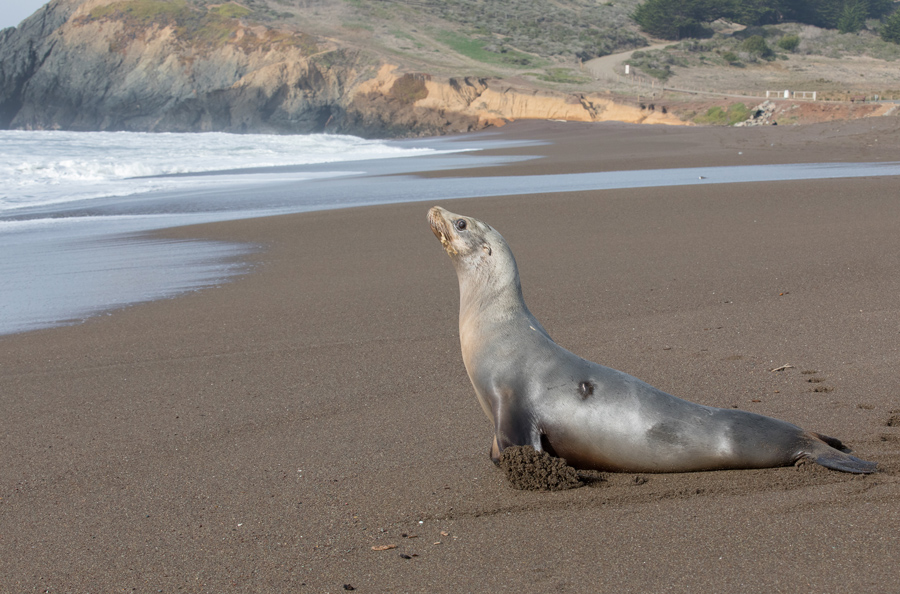The familiar cackling sound of northern elephant seals and soft “mah, mah” vocalizations of harbor seals mark their return to local beach rookeries to give birth to their pups. With Spring underway, the opportunity for visitors and locals to see wildlife – and these adorable pups – up close – is part of what makes California so special.
As more and more seal mothers give birth to pups on local beaches, The Marine Mammal Center is about to enter their busiest rescue season of the year. Currently, more than 150 patients are on-site at their Sausalito hospital and growing every day. The Center wants to remind locals and visitors alike that a great wildlife viewing experience starts with giving these animals the safe distance to be wild and what they should do if an animal appears to be in distress.
Last year, The Marine Mammal Center responded to 86 seals, sea lions and sea otters that had to be rescued due to negative human interaction across the Center’s response range. That number was a cause for concern as it’s significantly higher than the historical average of 40-60 cases per year. Please save the SEAL-FIE for later and remember, sometimes long distance love can be a beautiful thing! Each marine mammal the Center responds to is a window into the overall health of our ocean and so to kick off Spring, they’ve put together three easy viewing reminders to safely observe and enjoy these animals.
THREE BEST TIPS TO SAFELY VIEW PUPS
Young pups, especially newborn harbor seal pups, have are incredibly photogenic and draw attention with their innate charm. But both mom and pup aren’t keen on up-close selfies and don’t make good playmates with your dog or kids! These young pups are at the most vulnerable stage of their life and can be easily become stressed, separated and/or abandoned by their mothers if humans or dogs get too close. Here are three tips to keep in mind when enjoying the beauty of the northern California coastline:
- Keep The Safe Distance. Whether on the water viewing marine life in a kayak or seal pups on local beaches, a great wildlife viewing experience starts with keeping your distance.
- Use Your Zoom. It’s ok to take photos and admire the animals, but if you’re so close that you’re not using your zoom or they’re reacting to you, then you’re too close. No SEAL-FIES please!
- Call Us. If you see a seal or sea lion in distress, call The Marine Mammal Center’s rescue hotline at 415-289-SEAL (7325). The Center will monitor the animal and, if necessary, send a trained responder to rescue it safely.

Tchotchke the sea lion is released back into the ocean by The Marine Mammal Center in December, 2017.
A STORY TO REMEMBER
This spring, a weeks old male harbor seal pup named Boulders was rescued by trained volunteers from The Marine Mammal Center after being found surrounded by well-meaning beachgoers at Fort Ross State Park in Sonoma County. Rescuers noted that members of the public were petting the young pup and trying to feed it. Due to the animal’s condition and negative interaction, Boulders was rescued and brought to the Center’s Sausalito hospital for rehabilitation. Center veterinarians diagnosed the male pup with malnutrition and maternal separation. Luckily for Boulders, with the help of our dedicated staff and volunteers, he’s responding well to treatment at the hospital and is receiving a second chance at life.
Though Boulders’ story had a happy ending, unfortunately, his case is not an outlier. In total, 86 seals, sea lions and sea otters were rescued in 2018 due to negative human interaction across the Center’s rescue range stretching from San Luis Obispo County to Mendocino County.
ABOUT THE MARINE MAMMAL CENTER
At the Marine Mammal Center, we are guided and inspired by a shared vision of a healthy ocean for marine mammals and humans alike. Our mission is to advance global ocean conservation through marine mammal rescue and rehabilitation, scientific research, and education. Since 1975, the Center has been headquartered in the Marin Headlands, Sausalito, Calif., within the Golden Gate National Parks and has rescued and treated more than 20,000 marine mammals. In 2014, the Center opened Ke Kai Ola, a hospital for the rehabilitation of the endangered Hawaiian monk seal, in Kailua-Kona, Hawai’i.

